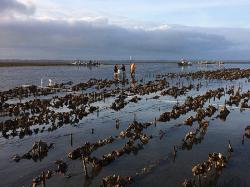ARS Strategies To Benefit Aquaculture Industry
January 10, 2018 | 1 min to read

Although the global aquaculture industry produced 73.8 million tons of fish and shellfish, with an estimated first-sale value of $160.2 billion in 2014, the United States is still the leading global importer of fish and fishery products. Ninety percent of the seafood we eat comes from foreign waters, and half of that amount is from aquaculture. Thus, there is significant opportunity to increase U.S. aquaculture production.
Aquaculture refers to the breeding and raising of fish and shellfish. These practices can sometimes stress the environment by adding nutrients to waterways, such as ponds, lakes, rivers, and oceans. Scientists with the Agricultural Research Service (ARS) are working diligently to find ways to mitigate any negative environmental impacts from aquaculture.
Raising Fish in a Closed System
One way to produce more fish products is in land-based closed-containment aquaculture systems. In 1989, ARS scientists at the National Center for Cool and Cold Water Aquaculture (NCCCWA) in Leetown, West Virginia, conducted the first of several research projects to develop recirculating water systems to help producers provide more fresh seafood for market. ARS also provides funding to The Conservation Fund’s Freshwater Institute (TCFFI), in Shepherdstown, West Virginia, to develop these kinds of technologies. Recirculating water systems can help increase the amount of fish available to markets while solving some of the problems inherent in open-water fish farms.
To read the rest of the story, please go to: AgResearch Magazine
